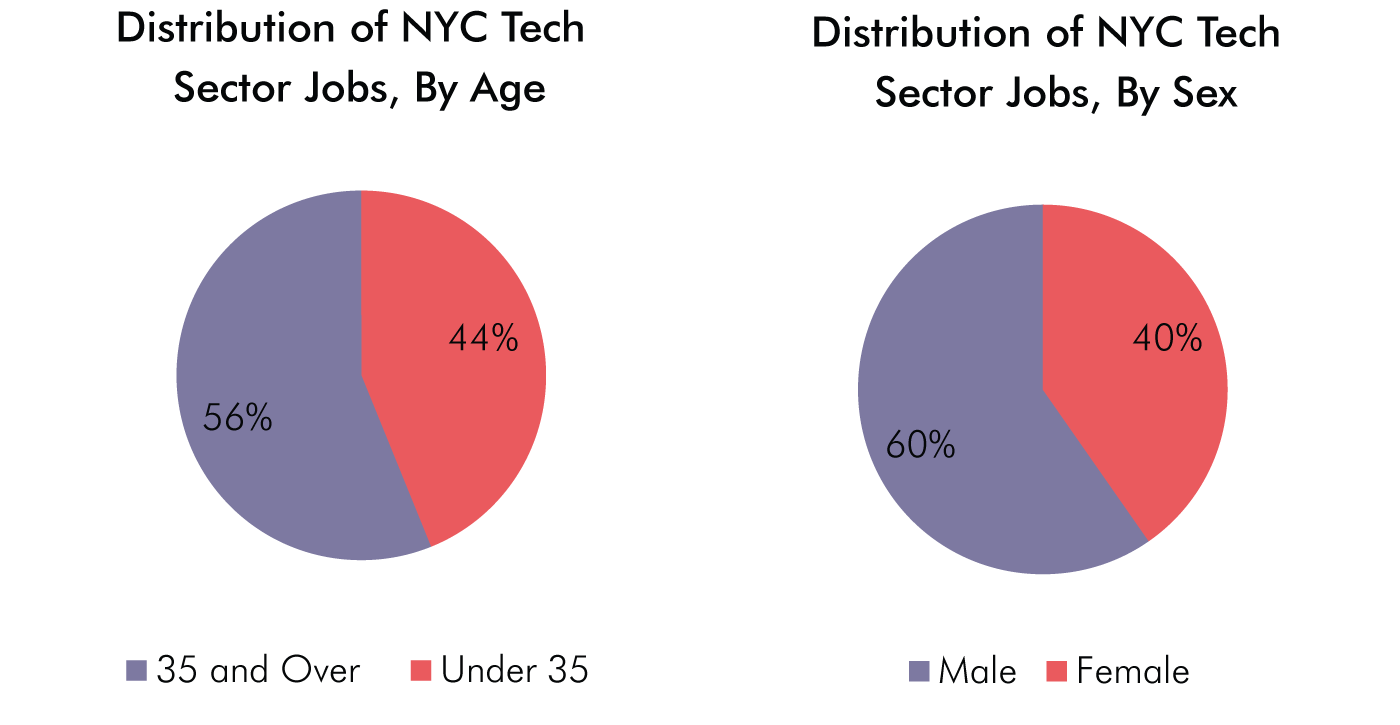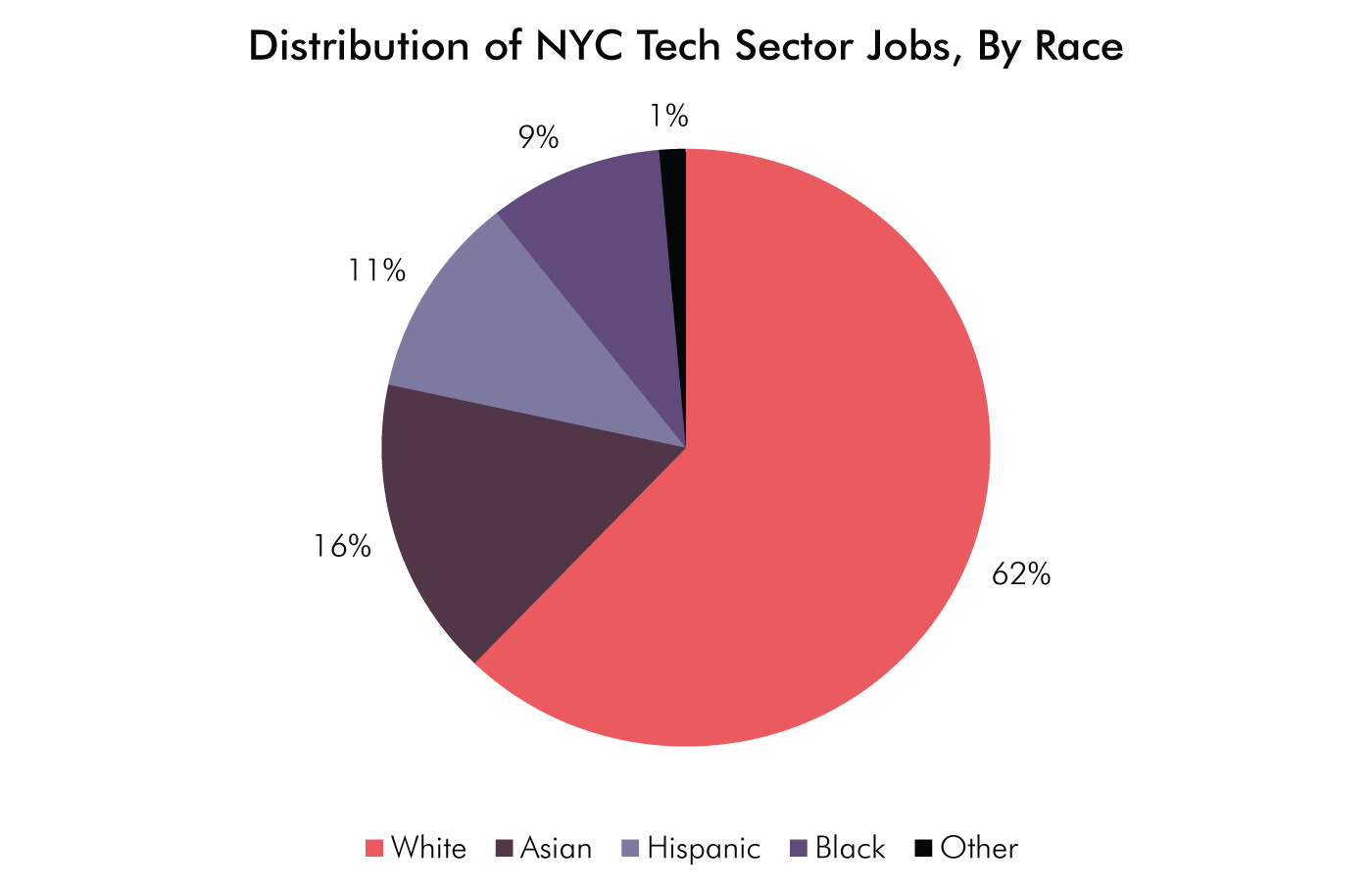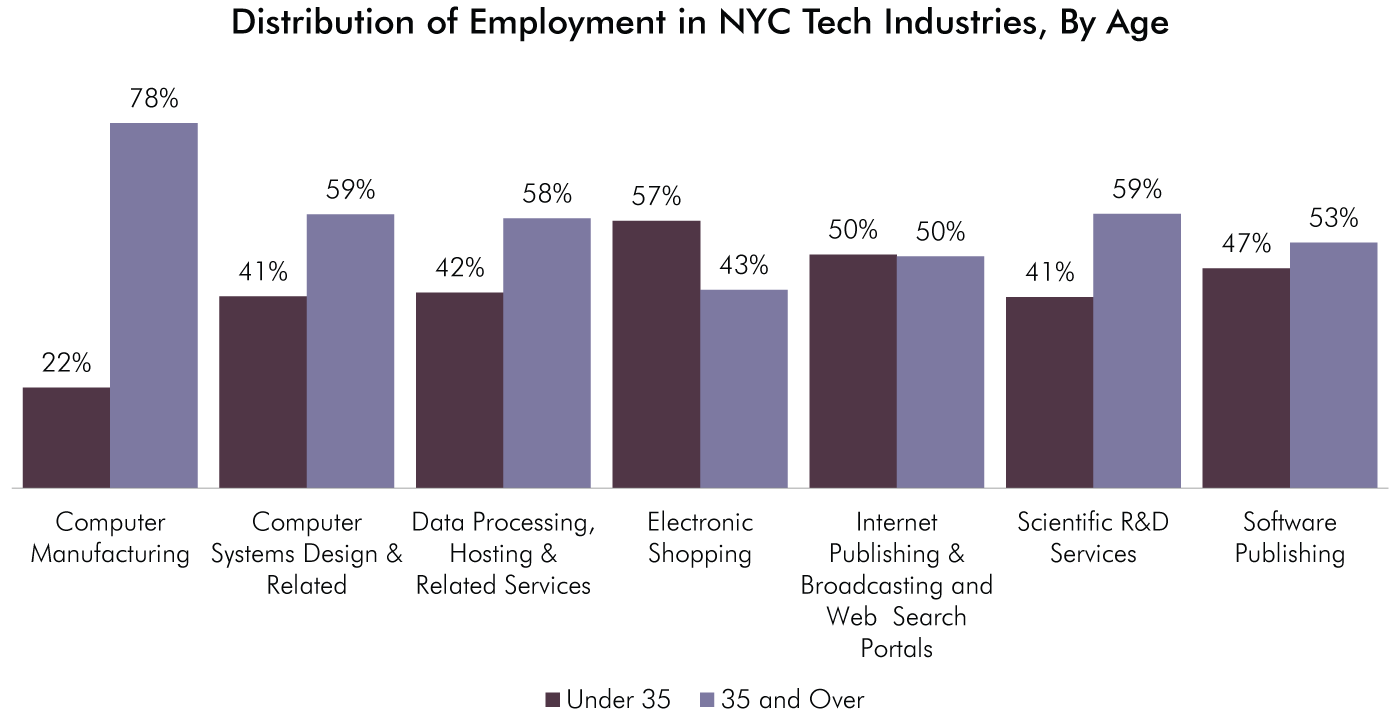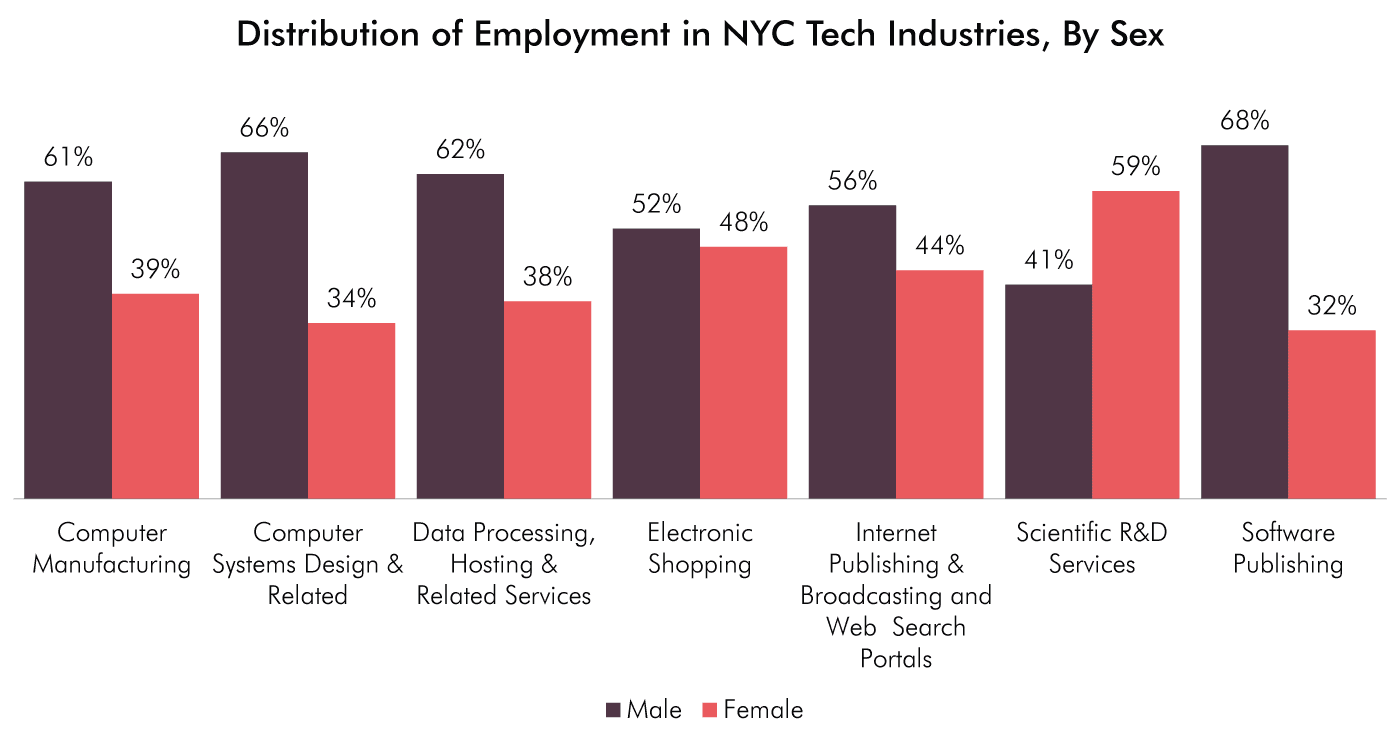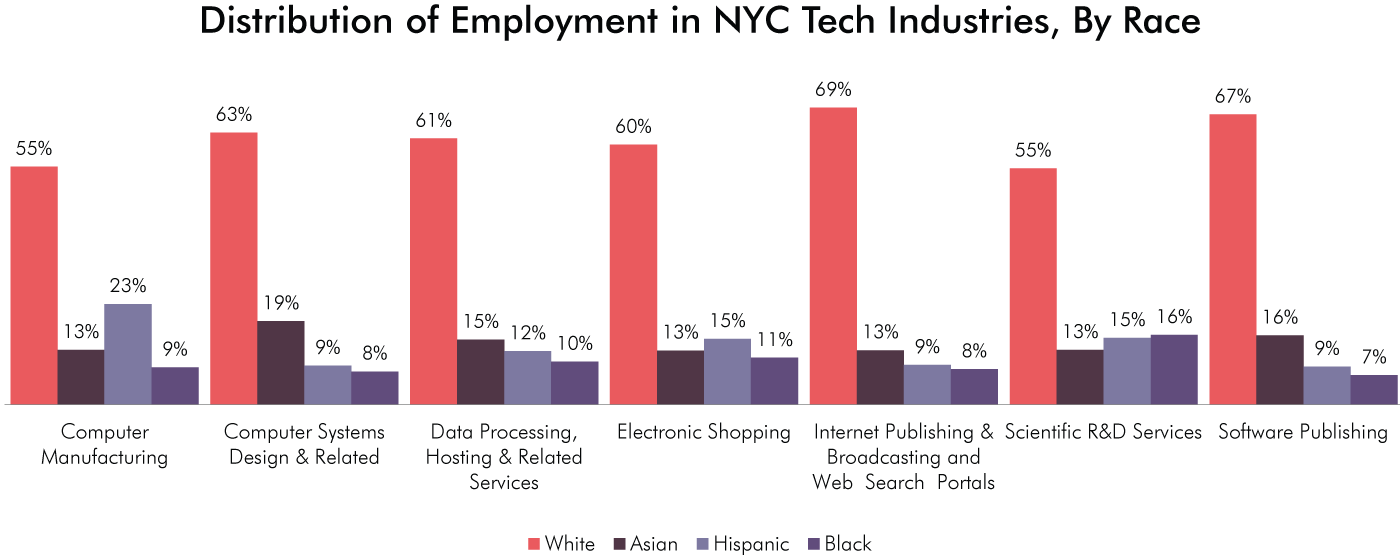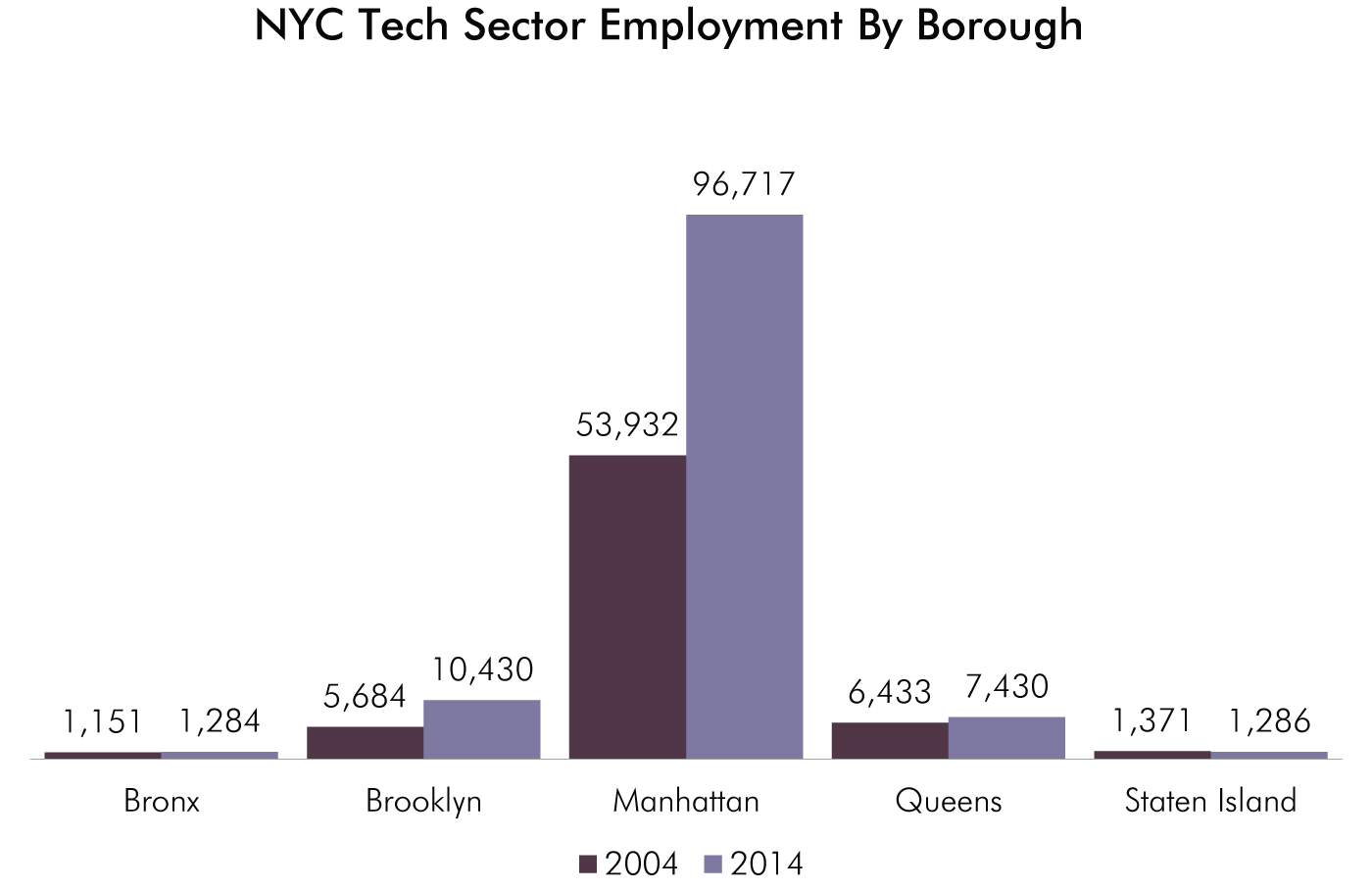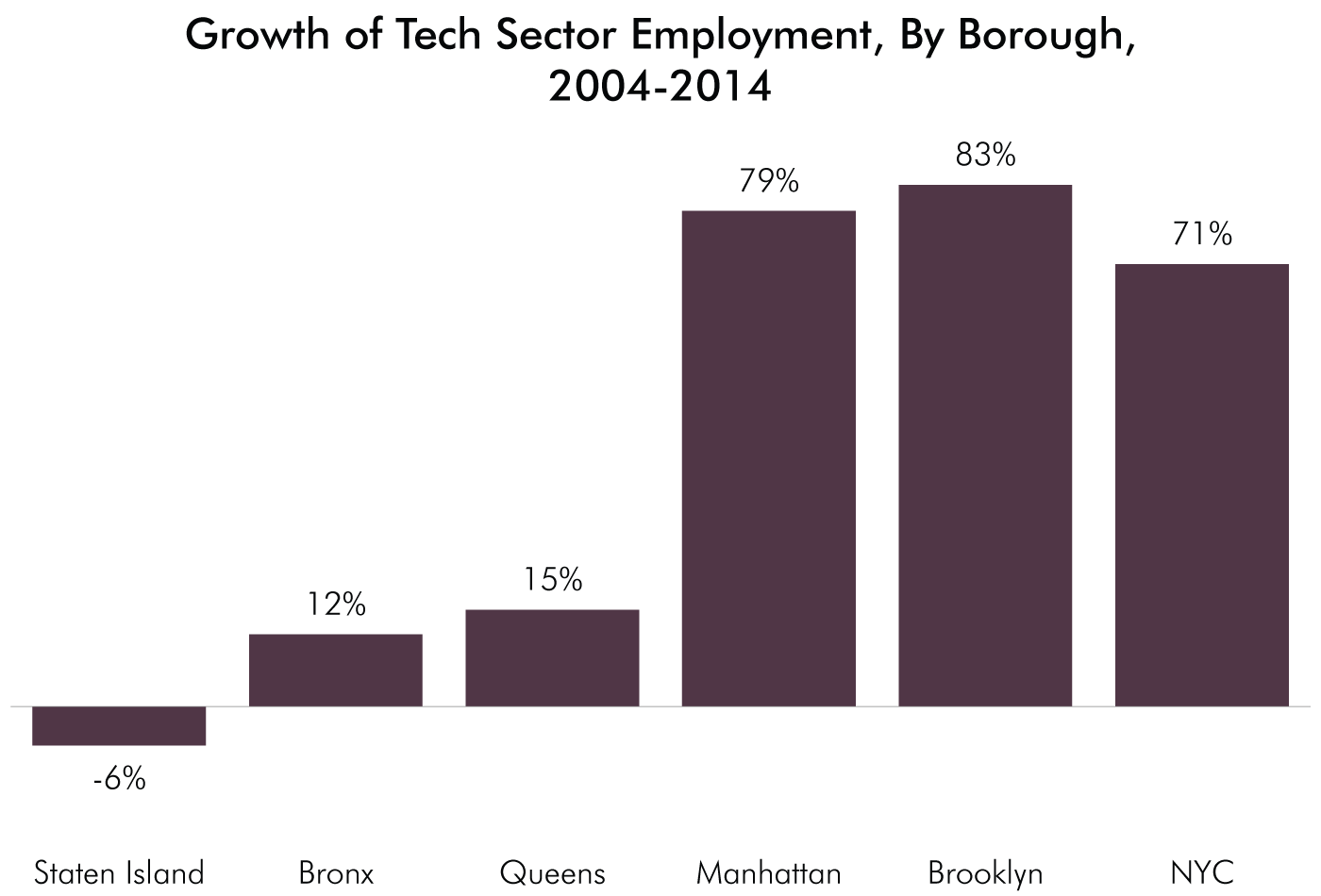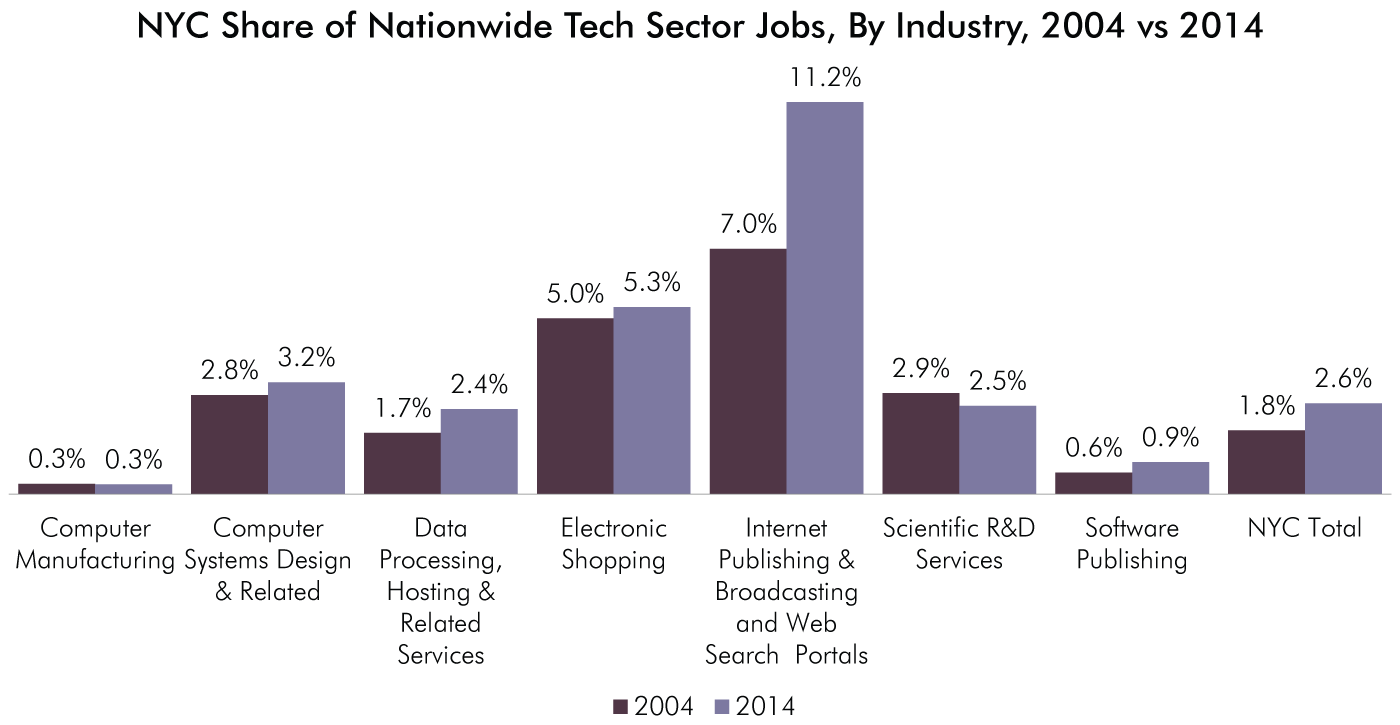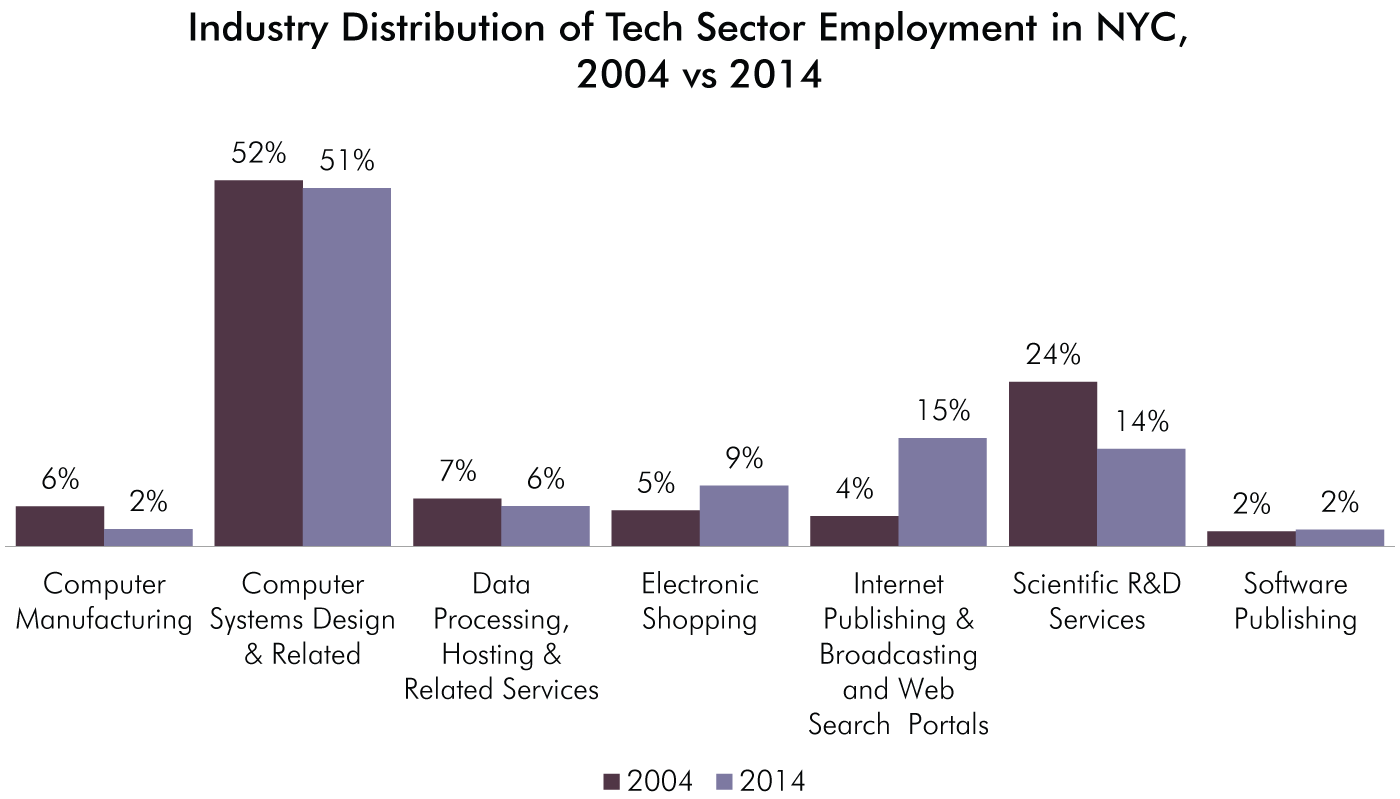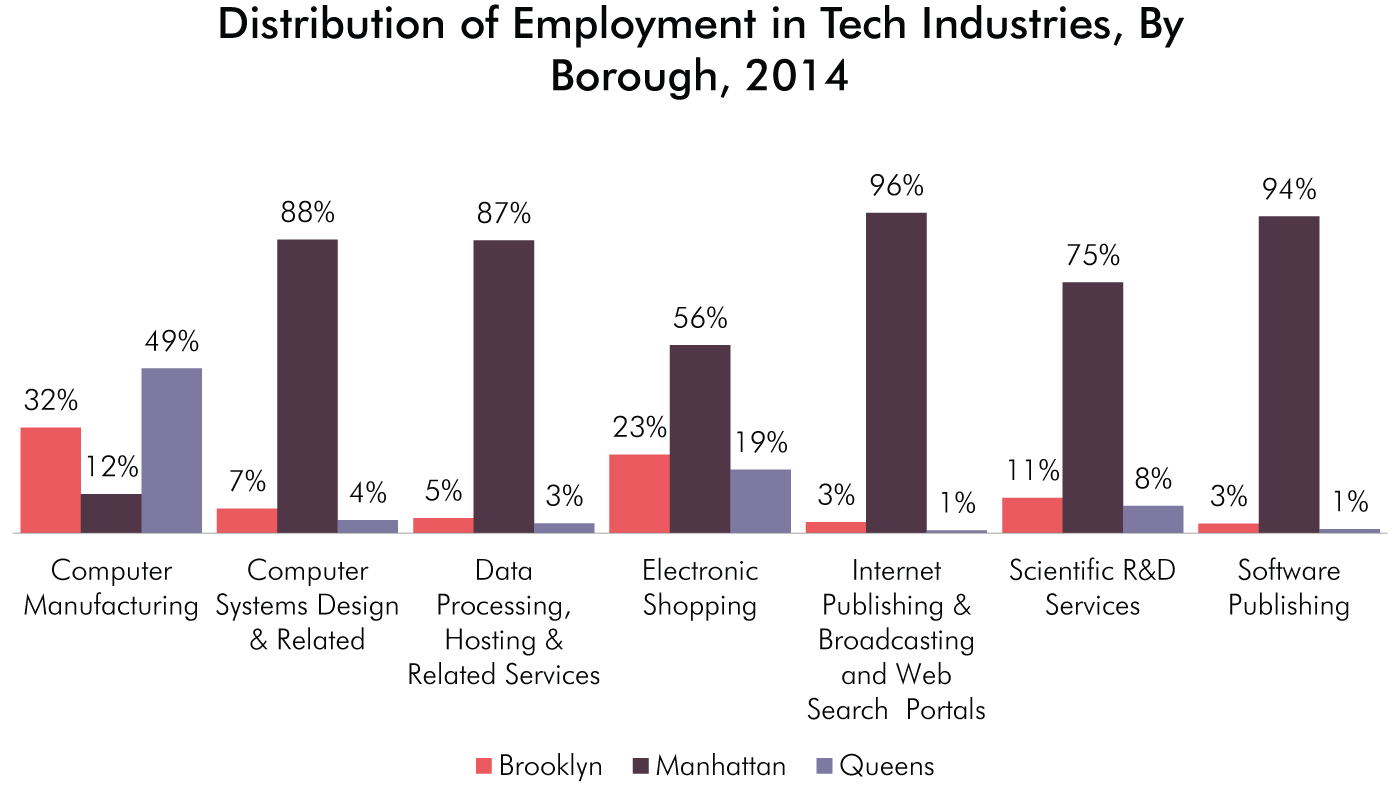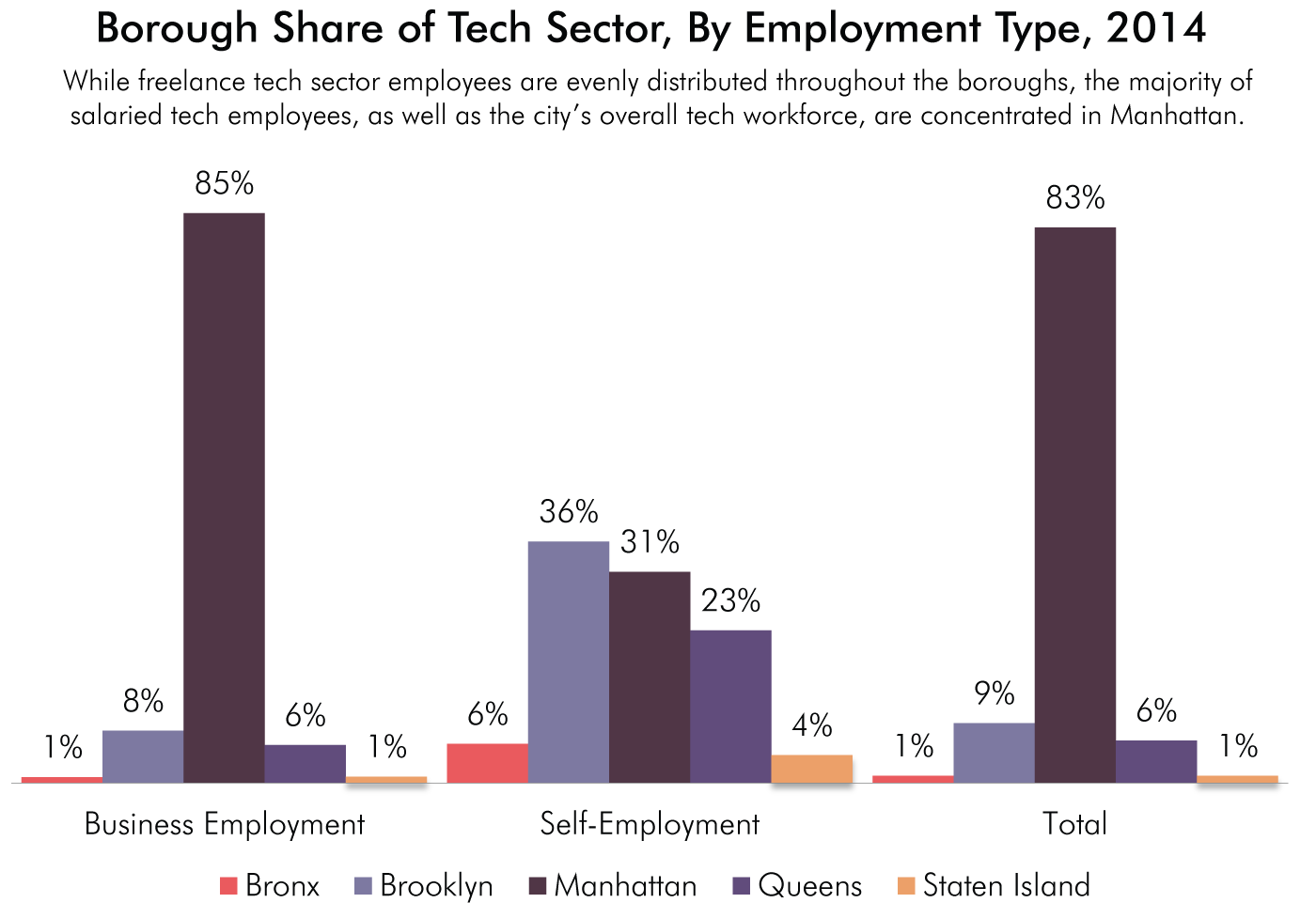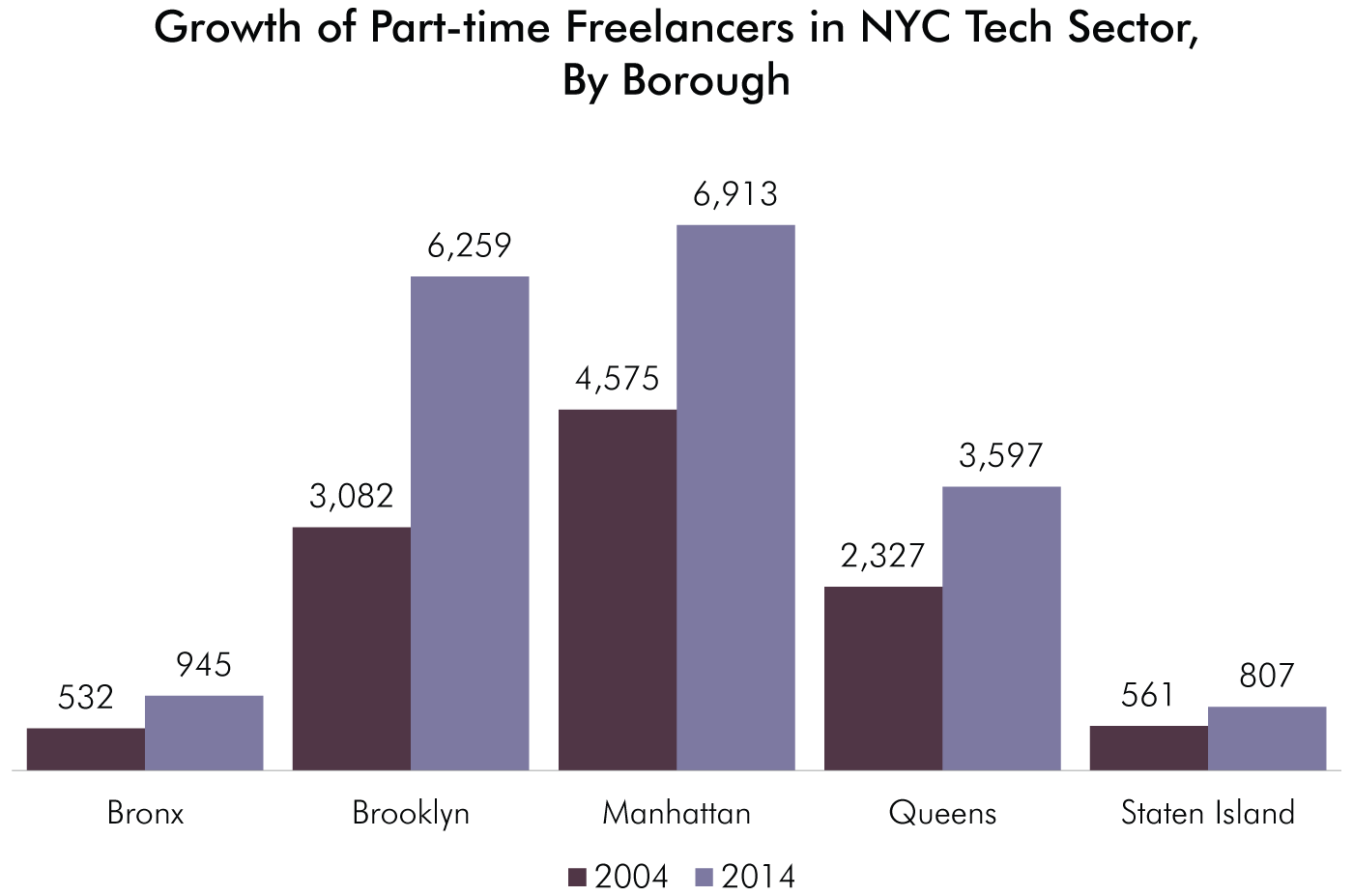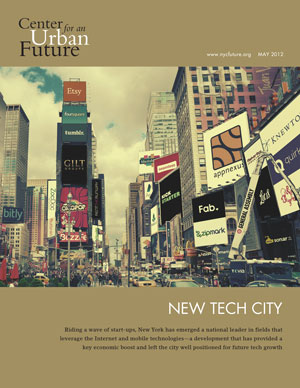While there’s no debating the meteoric rise of New York City’s tech sector over the past decade, an accurate and representative measurement of employment in the tech sector has proven elusive. Last month, however, the Federal Reserve Bank of New York published a new report that arguably provides the most accurate measurement of the city’s tech sector, using a definition that is limited to seven industries "in which firms use technology as their core business strategy."1
In this analysis, we use the Fed’s definition as a jumping off point to provide a more complete portrait of New York’s tech sector. Our analysis documents which boroughs have experienced the fastest tech growth, which tech subsectors have the most jobs and how employment in the sector breaks down by age, gender and race/ethnicity.
Using the Fed’s definition of the tech sector—which includes seven industries: Computer Manufacturing, Electronic Shopping, Software Publishing, Data Processing & Hosting, Internet Publishing & Broadcasting & Web Search Portals, Computer Systems Design and Scientific R&D Services—we detail the following trends:
-
New York City’s tech sector employed 117,147 people in 2014, a 71 percent increase from a decade earlier (68,571).
-
51 percent of the city’s tech sector employment is in the Computer Systems Design industry, by far the largest share of any tech subsector. This industry encompasses most of the tech startups in the city. The next largest share of tech jobs are found in Internet Publishing & Broadcasting and Web Search Portals (15 percent), followed by the Scientific R&D Services industry (14 percent of the total), Electronic Shopping (9 percent), Data Processing, Hosting & Related Services (6 percent), Computer Manufacturing (2 percent) and Software Publishing (2 percent).
-
The fastest growth in tech employment over the past decade occurred in the Internet Publishing & Broadcasting and Web Search Portals industry. Employment in this industry jumped by 516 percent (2,947 to 18,155) between 2004 and 2014. It was followed by a 188 percent rise in Electronic Shopping (3,521 to 10,154), 93 percent in Software Publishing (1,445 to 2,795) and 67 percent in Computer Systems Design (35,930 to 60,103).
-
In 2014, 2.6 percent of the nation’s tech sector jobs were located in New York City, up from 1.8 percent in 2004. The concentration of jobs located in New York rose in each of the seven tech subsectors, except for Scientific R&D Services. From 2004 to 2014, the share of the nation’s job in Internet Publishing & Broadcasting and Web Search Portals industry rose from 7 percent to 11.2 percent. As of 2014, 5.3 percent of the nation’s jobs in Electronic Shopping and 3.2 percent of jobs in Computer Systems Design were located in the city.
-
Brooklyn had the fastest growth in tech sector of any borough, with the number of jobs increasing by 83 percent (from 5,684 to 10,430). The tech sector grew by 79 percent in Manhattan (53,932 to 96,717), 15 percent in Queens (6,433 to 7,430) and 12 percent in the Bronx (1,151 to 1,284). Tech sector employment decreased by 6 percent in Staten Island (1,371 to 1,286).
-
Manhattan is home to 83 percent of all tech sector jobs in the city. Brooklyn has the second largest share (9 percent), followed by Queens (6 percent), the Bronx (1 percent) and Staten Island (1 percent).
-
Manhattan accounts for 96 percent of the city’s jobs in Internet Publishing & Web Search Portals, 94 percent in Software Publishing, 88 percent in Computer Systems Design, 87 percent in Data Processing & Hosting, 75 percent in Scientific R&D Services, 56 percent in Electronic Shopping and 12 percent in Computer Manufacturing. Brooklyn is home to 32 percent of jobs in Computer Manufacturing and 23 percent in Electronic Shopping. Queens is home to 49 percent of jobs in Computer Manufacturing and 19 percent in Electronic Shopping.
-
44 percent of employees in the city’s tech sector are under the age of 35. While workers under the age of 35 comprise only 22 percent of those working in the Computer Manufacturing subsector, these young workers make up 57 percent of the workforce in Electronic Shopping, 50 percent in Internet Publishing & Web Search Portals and 47 percent in Software Publishing.
-
60 percent of tech sector employees are male, with the highest percentages of male employees found in Software Publishing (68 percent), Computer Systems Design (66 percent), Data Processing & Hosting (62 percent) and Computer Manufacturing (61 percent). The subsectors with the highest ratio of female employees are Scientific R&D Services (59 percent female), Electronic Shopping (48 percent) and Internet Publishing & Web Search Portals (44 percent).
-
62 percent of tech sector employees are white, 16 percent Asian, 11 percent Hispanic and 9 percent African American. The largest shares of white employees are in Internet Publishing & Web Search Portals (69 percent), Software Publishing (67 percent) and Computer Systems Design (63 percent). The lowest shares are in Computer Manufacturing (55 percent) and Scientific R&D Services (55 percent).
-
Hispanics make up 23 percent of employment in Computer Manufacturing, but just 9 percent in Computer Systems Design, Software Publishing and Internet Publishing & Web Search Portals. African Americans make up 16 percent of employees in Scientific R&D Services, but just 8 percent in Computer Systems Design and Internet Publishing & Web Search Portals and 7 percent in Software Publishing. Asians make up 19 percent of employees in Computer Systems Design and at least 13 percent of total employment in all seven tech industries.
-
The vast majority of full-time tech sector employment is located inside firms, with tech sector self-employment actually falling by 7 percent over the past decade (5,047 to 4,708), while firm-level employment rose 77 percent (63,524 to 112,439).
-
Though not included in our aggregate employment numbers, there was a 67 percent increase (11,077 to 18,521) in the number of “extended proprietors” in the tech sector—those who derive a portion of their income from a side business. Of these extended proprietors, 37 percent are based in Manhattan (6,913), 34 percent in Brooklyn (6,259) and 19 percent in Queens (3,597). 45 percent of extended proprietors are working in Computer Systems Design, 17 percent in Electronic Shopping, 13 percent in Data Processing and 12 percent in Internet Publishing & Web Search Portals.
Like the New York Fed, our data draws primarily from the Department of Labor’s Quarterly Census of Employment and Wages. However, while the Fed accessed this data through the Moody’s Economy.com database, we used the Economic Modeling Specialists International portal because it provides demographic and self-employment figures. Any small variations in the data are due to the different databases.
1 Undoubtedly, the number of people working in technology jobs goes well beyond those employed in the seven industries that make up the “tech sector”. Indeed, businesses in most industries today are integrating technology into their operations. This analysis focuses on only the more narrow “tech sector” to better understand trends occurring at companies that "use technology as their core business strategy.”
